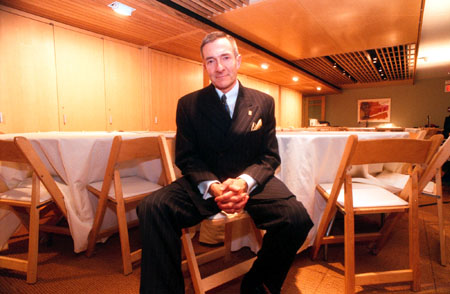Native American voices to be heard at new museum

To create a sanctuary to honor an entire, complex culture one rich in history and language and lore that flourished for thousands of years on this continent before being virtually annihilated in just a few decades: that is the challenge for W. Richard West, founding director of the National Museum of the American Indian (NMAI) at the Smithsonian Institution, who spoke at Harvard last week.
West’s speech, which touched on the history, the controversies, and the complexities of his undertaking, served as keynote address for the “Stewards of the Sacred” conference, sponsored by the Center for the Study of World Religions (CSWR) at Harvard Divinity School. It also kicked off a new religion-and-the-arts initiative at the center, consisting of a 10-month colloquium series featuring directors from a range of institutions.
“This is a national museum that takes the permanence, the authenticity, the vitality, and the self-determination of Native American voices as the fundamental reality it must represent,” West told a large audience at the Arthur M. Sackler Museum auditorium, Wednesday, Feb. 7.
Established by an act of Congress in 1989, the NMAI will house an extensive collection of Indian artifacts, photographs, and papers more than 800,000 in all from nearly all tribes in the United States. Two of its facilities, the Cultural Resources Center in Suitland, Md., and the George Gustav Heye Center in New York City, have already opened. The NMAI’s signature facility, on the National Mall in Washington, is scheduled to open in 2004.
“The efforts of the NMAI are noteworthy not necessarily for their uniqueness,” West said, “but for the scale of the effort given the size of our institution and its seat within that paragon of American cultural representation: the Smithsonian Institution.”
Citing the “10-year-long journey” of defining both the Museum’s mission and its prime exhibition space, West described his intent to create a living memorial that tells the story of Native peoples not only through their objects, but through what those objects represent.
“This fusion of the profoundly spiritual with the otherwise purely physical, this primacy of the process of creating an object over the beautiful object itself, this utter inseparability of the object from the conduct of daily life all are Native ways of viewing objects that are arguably significantly different from the paradigms of Western knowledge,” he told the audience.
“Through the millennia, those Indian people we now call artists were not so much in the business of producing art as they were in creating aesthetically often remarkable material, material whose primal importance lay not in the object itself, but in the fact that it reflected, indeed embodied the processes ceremonial and ritualistic that defined the very community culturally.”
Museum officials have worked closely with the tribes in a “bottoms-up, inside-out” fashion, according to West, holding some two dozen consultations with Native peoples and others from throughout the hemisphere during the early planning stages of the NMAI. “We met with groups on a regional basis as well as with Native museum directors, educators, political leaders, contemporary artists, and religious elders,” he said.
“We were told consistently by Native peoples and communities that they wished to be depicted as the contemporary cultural phenomena that they are, rather than as some romanticized cultural residuum frozen forever in time and place,” West continued. “They wanted an active, participatory role in their own representation in our galleries and associated public programs.”
Native American concepts and aesthetics are also integrated into the Mall museum’s unusual design, West proudly pointed out. “They [wanted to ensure that] the membrane between the built- and nonbuilt environments would be as visually transparent as possible, thus serving as metaphor for the native sense of connectivity between human beings and all of nature.”
The museum has also created a department of community services to serve as a liaison with Native communities and to function as their advocate within the museum hierarchy. “We believe and act on the belief that authenticity, authority, and expertise sit outside the museum as well as within it,” West explained. “And thus ours is a shared authority at most.”
The payoff will come, he told the audience, when the Mall museum doors finally open to the public in three years.
“We are obviously a cultural place of importance for the millions of visitors, most of them non-Native, who will pass through our building on the National Mall each year,” West said, “and who hopefully will see Native peoples, their communities, and their material culture in new and meaningful ways as a result of the presence of Native peoples and their insights and thinking in all that we do.
“But as important, we will become … a community or civic place and space, physical and virtual, for the millions of Native peoples who still call the western hemisphere home and who hope for (indeed, I believe, will insist upon) a cultural future.”
The growing spiritual dimension affecting museum exhibitions and operations around the world was the primary topic of discussion during last week’s conference.
“Museum leaders were amazed to discover that their individual experiences of change were unanimously shared by others, that treating religious objects with a full range of traditional care practices was transforming their institutions at every level,” said Lawrence Sullivan, director of CSWR and professor of the history of religion. “As someone who specializes in religion, I was in awe to see the power of the spiritual dimension to remodel museums, institutions so important in the formation of democracies.
“The participants … signaled that they hoped this first meeting would be a launching point of an ongoing international collaboration to help them become the best ‘stewards of the sacred’ they can become,” Sullivan concluded.




